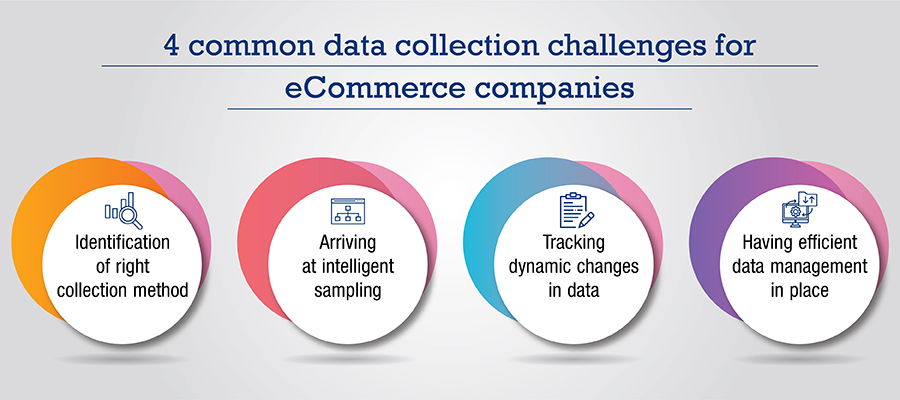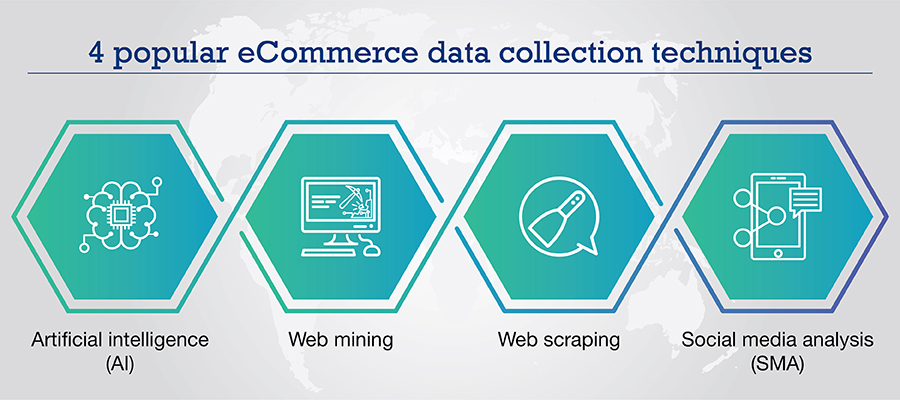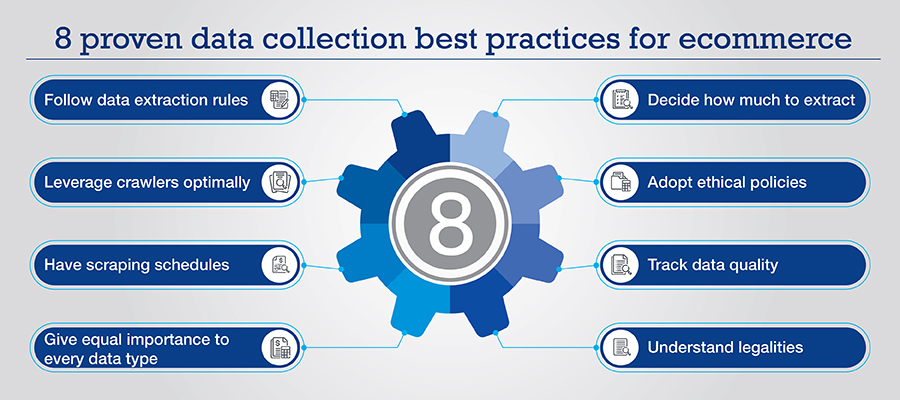
Right approach to data collection enables eCommerce companies to bring in the most accurate data, which paves a way for business efficiency and productivity improvement.
25% of the world’s total population shops online, and the pace at which it is increasing, days are not far when most of us will be using online platforms for buying even the pettiest item required for daily use. Well, as online retail continues to grow fast, eCommerce companies find themselves gripped with certain challenges, amongst which one is data collection. As companies manage to increase their market share and bring new portfolios in quick succession, they look for effective solutions to pool every piece of required data.
This guide aims to take you through the nitty-gritties of data collection for eCommerce players. Let’s go through key drivers associated with accurate and timely data collection.
Why right data collection so important for eCommerce companies?
78% of eCommerce companies believe that data collection is a decisive parameter that governs the success of their business strategies.
Ecommerce websites generate huge volumes of data encompassing customer interactions, purchases, visits, product sales, reactions to ad campaigns, etc. In addition to this internal data, there are external data – insights from competitor websites that need to be gathered on a regular basis.
The data exists in structured as well as unstructured forms, and to rightly gather it, having dynamic data collection mechanisms becomes imperative.
Robust and agile data collection mechanisms allow stakeholders to be accurate in collecting the right data at the right time. While this facilitates effective KPI monitoring, it also improves the efficiency of performance analysis.
At a strategic level, data collection efficiency matters and plays a huge role in shaping customer strategies – maximizing customer value, expanding customer base, increasing conversions, etc.
What are common data collection challenges for eCommerce companies?
Data collection challenges that eCommerce companies usually grapple with include:

Identification of right collection method
Type of data, its amount, and source along with other factors render a complex character to it. So, the application of an appropriate method is required to facilitate successful data extraction. Data must be reliable, accurate, and valid, and to ensure each of these parameters, even a combination of techniques maybe need to be applied.
Arriving at intelligent sampling
Online stores generate massive volumes of data each day. However, analyzing such tremendous volumes can pose processing challenges, and so, often, data scientists and analytics professionals use samples that aptly represent the characteristics of the population. Sample size calculation is a complex activity and requires to be executed in quick succession.
Tracking dynamic changes in data
Visitor demographics keep changing – income levels update with time, people switch jobs, family structure changes, people relocate to different geographies, etc. eCommerce companies need to regularly monitor and analyze these external changes. On the other hand, they also need to keep an eye on internal changes related to changes in customer preferences, purchase patterns, etc.
Having efficient data management in place
Given the ever-changing nature of data, eCommerce companies find it difficult to answer “how much data to hold”, “when to consider data obsolete”, “when to enrich data”. Strategically answering these questions is necessary as they form the foundation for the overall data collection activity.
Techniques for eCommerce data collection
Advanced tools and technologies are enabling fast and accurate data extraction in the eCommerce space. Let’s have a look at some of these tools and how they have been bringing revolution.

Artificial intelligence (AI)
eCommerce companies have been increasingly relying on the use of artificial intelligence (AI) to address out-of-the-box requirements prompted by dynamically characterized data. Machine learning and deep learning mechanisms such as neural networks, computer vision, and natural language processing (NLP) enable efficient extraction of the minutest information from web sources.
Web mining
It is a class of techniques that better classify web pages before collecting data from different portions of websites. Here are some techniques it deploys:
Web content mining (WCM) extracts information including text, image, audio, and video from web content. This data is mined to discover interesting and useful patterns.
Web structure mining (WSM) helps analyze web page hyperlink structure and collects information contained therein. It also determines how two or more websites are interconnected, which is important while analyzing commercial websites.
Web usage mining (WSM) gives an understanding of visitor records collected in weblogs to further assess usage patterns and user behavior through automatic discovery and clickstream analysis.
Web scraping
Scraping can be done manually and in an automated matter as well. In manual scraping, all required information from the source website is copied and pasted to study them and to keep track of requisite metrics.
In automated scraping, bots and crawlers are leveraged. They automatically scrape data from desired websites. Their productivity is very high as compared to manual methods, and so time and costs are optimized.
Social media analysis (SMA)
eCommerce companies can tap into their official accounts across different social media platforms to obtain data on customer sentiment towards their brand. Data can come through feedbacks, reviews, etc. shared by people on social media. Social media analysis (SMA), therefore, gives retailers access to immense information on the area of interest.
Hitech assisted a US-based furniture retailer to get regular insights into competitor pricing strategy. As a solution, a customized crawler was deployed that explored multiple websites simultaneously. The crawler had a dynamic mechanism to track product visibility over fixed periods. Through the solution, the client got accurate details about competitor pricing at regular intervals, which enabled it to formulate effective pricing strategies. The implementation helped in increasing traffic by 20%, leading to a corresponding increase in sales.
Ecommerce data collection best practices
Data extraction operations involve multiple stakeholders. It is imperative for eCommerce companies to act responsibly while extracting data. Understanding the sensitive nature of customer information, ethical considerations must be the top priority. Following are the best practices that must be followed while collecting data:

Follow data extraction rules
Websites have rules set to control bot interaction and regulate data extraction. Before initiating data extraction from a website, first, understand these rules and follow them. Non-compliance can lead to legal troubles. Check out if the website allows bots and crawlers or not, lest the unauthorized access is considered a cyber-attack.
Leverage crawlers optimally
Websites are not just to extract data. Be responsible for setting crawler across the website. Unleashing crawler all the time can affect the website performance badly. Crawlers must be set on the target website at spaced intervals.
Have scraping schedules
At any given time when multiple users are accessing the website, an additional load of scraping decreases the processing performance of the site. A best practice is to extract data during off-peak hours. To speed the data extraction process, therefore, always pre-decide on when to scrape.
Give equal importance to every data type
Data related to demographics is not all. Incorporate mechanisms in data collection strategy, which enables access to psychographic data also. Understanding psychographics is critical to drive marketing strategies in correct direction.
Decide how much to extract
Given the immense traffic on eCommerce websites, eCommerce companies can extract as much data they want. But, have a clear idea about how much data meets your business requirements. Even if you are equipped to extract a high amount of data at a time, don’t end up extracting duplicate or bad data. So, always extract data in optimal quantities.
Adopt ethical policies
Your ability to extract data doesn’t make you its owner. Understand and have a strong idea on what are the accepted norms for obtaining data from external data sources. Having strong ethical guidelines always helps to keep away from getting involved in wrong practices and prevents violation of copyright laws.
Track data quality
Ecommerce sites capture new data every other second, making the extraction process highly dynamic. While extracting data, ensure that the quality of data is maintained, and the data extracted is recent and relevant to the context.
Understand legalities
The world’s topmost search engine and eCommerce companies run web crawlers, but they do not face any accusations. Because they abide by laws, do not misuse data, and take necessary permissions. By staying compliant with rules, online retailers keep themselves in the safe zone. While web crawling or web scraping is not unethical or illegal, do not overstep to give these activities an illegal character.
How leading eCommerce companies drive data collection for better decision-making?
Whether it is market segmentation, basket analysis, sales forecasting, or prevention of frauds, eCommerce companies have become heavily dependent on data. Here are some examples of how eCommerce giants have been collecting data to get a 360-degree view into customer interactions and their service performance for identifying growth opportunities.
- Amazon collects data around every single metric to get a thorough understanding of its audiences. It has developed a Comprehensive Collaborative Filter Engine (CFE) which captures every minute of customer detail, including the purchase history, shopping cart structures, wish lists, product researches, navigation patterns, etc. Apart from this, Amazon accesses external data from census and demographic databases. This data is fed into advanced analytics systems, dynamic pricing models, etc. to get useful insights. Strong data collection reinforces Amazon Web Services (AWS) and allows Amazon to generate 35% of its total sales through the initiative.
- EBay explores every channel to get access to customer footprints. While data points like transactions, ad preferences, cookies, page visits, etc. are captured automatically, eBay validates the authenticity of customer details from external sources and third parties, manually. A/B tests are executed to get an insight into user responses, feature updates, and policy changes. The data through various sources help eBay to build strong product positioning and efficient pricing strategies.
- Rakuten, the Japanese online retailing giant deploys a structured framework to collect the personal information of audiences. In fact, Rakuten Intelligence collaborated with Nielsen to combine the latter’s online purchase data (ePOS) and product reference data with the former’s consumer sourced panel. This offered Rakuten unparalleled visibility into customer interactions and merchants for all channels for the US market.
Conclusion
As eCommerce companies simply cannot overlook the data, they cannot even ignore the importance of data collection which has the power to change the course of analytics, and as a result, the concept acquires an important place in their tactical frameworks. Given the dynamic nature of eCommerce, even the data collection strategies must be dynamic so that no single element of information is missed. If data collection is aligned on correct lines, then it doesn’t just enable the discerning of insights but also optimizes time and cost.



